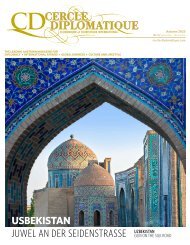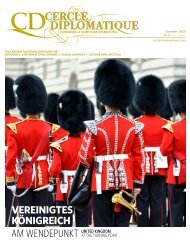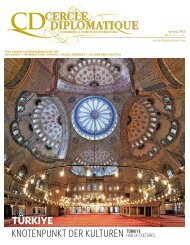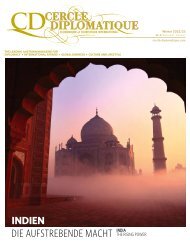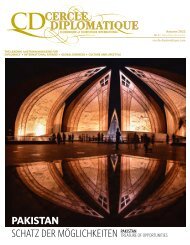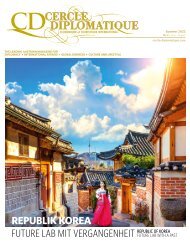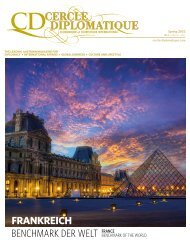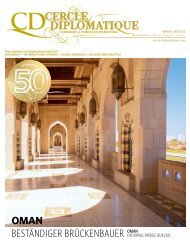IRAK DIE WIEGE DER ZIVILISATION
You also want an ePaper? Increase the reach of your titles
YUMPU automatically turns print PDFs into web optimized ePapers that Google loves.
SAVOIR-VIVRE RINGSTRASSE<br />
Titian | Rubens<br />
Rembrandt | Tiepolo<br />
Hieronymus Bosch<br />
INFO<br />
BUCHTIPP<br />
1865, 2015. 150 Jahre<br />
Wiener Ringstraße.<br />
Anlässlich des 150.<br />
Geburtstages der Wiener<br />
Ringstraße hat Wien<br />
Tourismus dreizehn<br />
international bekannte<br />
Autoren gebeten, sich<br />
Gedanken über den Prachtboulevard<br />
zu machen.<br />
Zu den Autoren zählen<br />
Sybille Berg, Eva Menasse,<br />
Marlene Streeruwitz und<br />
Wladimir Sorokin.<br />
On the occasion of the<br />
150th birthday of<br />
Ringstraße Vienna, Wien<br />
Tourismus asked thirteen<br />
internationally renowned<br />
authors to think about this<br />
magnificent boulevard. The<br />
authors include Sybille<br />
Berg, Eva Menasse,<br />
Marlene Streeruwitz and<br />
Vladimir Sorokin.<br />
–<br />
Metroverlag<br />
€ 19,90<br />
Auch die neue Wiener<br />
Universität fand Platz an der<br />
Ringstraße.<br />
The new Vienna University was<br />
also built on Ringstraße.<br />
from Sicardsburg, who designed the Vienna State<br />
Opera together with Viennese Eduard van der Nüll,<br />
did not come from the Austrian part of the monarchy,<br />
but the Hungarian part. Heinrich Ferstel, who<br />
designed the University of Vienna, Votivkirche church,<br />
the Museum for Applied Arts and the Palais<br />
Wertheim, came from Vienna.<br />
The dominant building style is historicism, with<br />
buildings from the Renaissance, Baroque and Gothic<br />
periods as role models. It is this stylistic mixture<br />
which makes Ringstraße so attractive. If you walk<br />
along Ringstraße today, you will notice the many luxury<br />
hotels located on this boulevard. However, they<br />
were not originally planned. Only in 1873, when Vienna<br />
hosted a world exhibition, and there was a demand<br />
for sophisticated accommodation, palaces and<br />
residences were turned into hotels. The oldest hotel<br />
on the Ring is the Grand Hotel between the State<br />
Opera and Schwarzenbergplatz; it was opened in<br />
1870, emerged from a residential house and impressed<br />
at the time with its advanced technical<br />
equipment – a mechanical lift and telephone in every<br />
room were a sensation. Above all the nobility relished<br />
this modern house – Crown Prince Rudolf regularly<br />
met his lover Mary Vetsera here. The Palais<br />
Württemberg, which is opposite the Grand Hotel,<br />
was also converted into a hotel. Today, the Hotel Imperial<br />
is still seen as one of the top addresses in the<br />
city. The history of the Palais Hansen on Schottenring<br />
is interesting. This huge palace should also have<br />
been used as a hotel during the world exhibition –<br />
but it took until 2013 when it actually became a luxury<br />
hotel. Today, the Palais Hansen Hotel Kempinski<br />
is one of the best Grand Hotels in Vienna.<br />
Right from the start, Ringstraße was the strolling<br />
promenade of the Viennese middle classes. In particular,<br />
the corner of Kärntner Ring and Kärntner<br />
Straße quickly developed into a hotspot. Because the<br />
leather goods shop Sirk was located here, this corner<br />
was soon called „Sirk corner“. If you arranged to<br />
meet on Ringstraße, you met here. With the strollers<br />
came the coffee houses. 150 years ago, there were 25<br />
big coffee houses on Ringstraße – only a few of them<br />
still survive today. Artists and entrepreneurs, the<br />
middle classes and simple people met here. They<br />
were egalitarian institutions. The most famous coffee<br />
house, even today, is Café Landtmann, which was<br />
strategically located in the hotspot of politics (City<br />
Hall Vienna, the Parliament, various party headquarters),<br />
art (Vienna Burgtheater) and science<br />
(University of Vienna). It is one of the most popular<br />
meeting points in the city. To this day, political press<br />
conferences and artist interviews are held here. Café<br />
Landtmann is located in the Palais Lieben-Auspitz.<br />
Above the coffee house, Berta Zuckerkandl once<br />
held her literary salon, where Arthur Schnitzler,<br />
Gustav Klimt, Gustav Mahler and many other artists,<br />
writers, musicians and other greats of the Vienna<br />
cultural scene met.<br />
However, Ringstraße was not just a strolling promenade.<br />
It was also the location for marches, demonstrations<br />
and parades. Austrian and European<br />
history was repeatedly written on Ringstraße. The<br />
first big parade took place in 1879. More than 14,000<br />
people took part in the festive procession for the<br />
25th wedding anniversary of Emperor Franz Joseph<br />
and his Sisi. Later, the First Republic was declared on<br />
the Ring (on 12 November 1918), and in 1934, there<br />
was such violent fighting in front of the Palace of Justice,<br />
that it ended in a civil war. On 15 March 1938,<br />
Adolf Hitler drove along the Ring in triumph to announce<br />
Austria’s inclusion in the German Reich at<br />
Heldenplatz. Even today, the “proletariat” still marches<br />
on Ringstraße on 1 May. Fan miles are set up, as<br />
with the European Football Championship in 2008,<br />
the participants of the Vienna City Marathon ran towards<br />
the finishing line, the Vienna Festival is opened<br />
here and the guests enter the Life Ball location,<br />
the annual charity event.<br />
In 2001, Ringstraße was named as a world cultural<br />
heritage site by UNESCO. Even today, it is still a<br />
place for strollers, a place for culture, politics and entertainment.<br />
PHOTO: RALPH MANFREDA<br />
Ausstellungen zum 150. Geburtstag der Wiener Ringstraße<br />
Exhibitions on the 150th birthday of Ringstraße Vienna<br />
Jüdisches Museum Wien<br />
Der Ring – ein jüdischer Boulevard.<br />
Die Ringstraße ist untrennbar mit dem Schicksal der jüdischen Unternehmer und Bankiers verbunden,<br />
die als Investoren eine wichtige Rolle spielten und die am Boulevard ihre großartigen Palais<br />
errichteten. Die Ausstellung im Jüdischen Museum Wien untersucht den Aufstieg dieser jüdischen<br />
Elite vor dem Hintergrund eines aufkeimenden Antisemitismus. 25. März bis 4. Oktober.<br />
Vienna The Ring - A Jewish boulevard. Ringstraße is inseparably linked with the Jewish entrepreneurs<br />
and bankers, who played an important role as investors and built their huge palaces on the<br />
boulevard. The exhibition in the Jewish Museum Vienna investigates the rise of this Jewish elite in<br />
light of a burgeoning anti-Semitism. From 25 March to 4 October.<br />
jmw.at<br />
Wien Museum<br />
Der Ring. Pionierjahre einer Prachtstraße 1857 bis 1865.<br />
Diese Ausstellung im Wien Museum konzentriert sich auf die Jahre zwischen 1857, als der Entschluss<br />
zum Bau der Ringstraße gefasst wurde, und 1865, dem Jahr der Eröffnung. Gezeigt werden Pläne,<br />
Modelle, Entwürfe und Fotografien, die die Planungsgeschichte des Boulevards erzählen.<br />
11. Juni bis 4. Oktober.<br />
The Ring. The pioneer years of a beautiful street 1857 to 1865. This exhibition in the Vienna<br />
Museum concentrates on the years between 1857, when the decision was made to build Ringstraße,<br />
and 1865, the year of the opening. Plans, models, drafts and photographs will be shown which tell the<br />
story of the boulevard. From 11 June to 4 October.<br />
wienmuseum.at<br />
Unteres Belvedere<br />
Klimt und die Ringstraße.<br />
Gustav Klimt war der bedeutendste Künstler der Gründerzeit. Ihm und den anderen bedeutenden<br />
Malern der Ringstraße – wie etwa Hans Makart – ist diese Ausstellung gewidmet.<br />
3. Juli bis 11. Oktober.<br />
Klimt and Ringstraße. Gustav Klimt was the most important artist of the founding period. This<br />
exhibition is dedicated to him and other meaningful painters of Ringstraße such as Hans Makart. 3<br />
July to 11 October.<br />
belvedere.at<br />
Architekturzentrum Wien<br />
Wien, die Perle des Reiches. Planen für Hitler.<br />
Auch der Führer hatte Pläne mit der Ringstraße. Das Architekturzentrum Wien zeigt die teilweise<br />
unbekannten Pläne Adolf Hitlers und der Nationalsozialisten für Wien und die Ringstraße.<br />
19. März bis 17. August.<br />
Vienna, the pearl of the empire. Planning for Hitler. The Führer also had plans for Ringstraße. The<br />
Architekturzentrum Vienna shows the sometimes unknown plans of Adolf Hitler and the national socialists<br />
for Vienna and Ringstraße. 19 March to 17 August.<br />
azw.at<br />
Österreichische Nationalbibliothek<br />
Wien wird Weltstadt. Die Ringstraße und ihre Zeit.<br />
Die Ausstellung zeigt, wie sich Wien von einer aristokratisch geprägten Stadt in eine moderne<br />
Metropole verwandelte. 22. Mai bis 1. November.<br />
Vienna becomes a world city. Ringstraße and its time. The exhibition shows how Vienna changed<br />
from a city characterised by the aristocracy to a modern metropolis. From 22 May to 1 November.<br />
onb.ac.at<br />
The Paintings Gallery of the Academy<br />
of Fine Arts Vienna<br />
94 Cercle Diplomatique 1/2015<br />
1., Schillerplatz 3 | Tue – Sun 10 am – 6 pm<br />
www.akademiegalerie.at<br />
Cercle Diplomatique 1/2015 95






